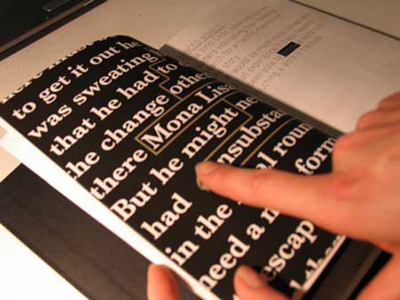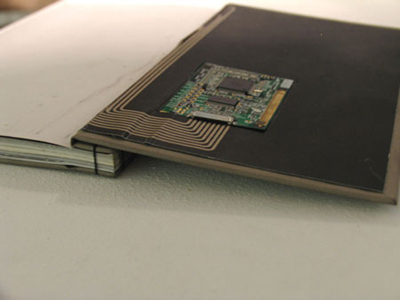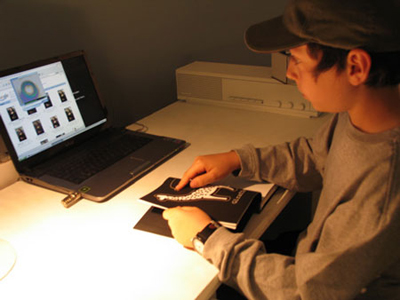Back in the summer, I visited the Royal College of Art’s 2006 Summer Show (a longer review of which can be found over at Tom Coates’ plasticbag.org). One project that caught my eye was Manolis Kelaidis’ blueBook project, part of the Industrial Design Engineering strand. Manolis was kind enough to send me some more material relating to the project.

As digital media in the form of portable devices, touch-screens and pervasive wireless networks offer new possibilities for interaction, the traditional book starts to look rather featureless when compared to electronic versions. But the traditional book has many advantages too – not least the comfort of tradition itself. The blueBook aims to find a compromise between these two objects, between the digital and the physical.
The blueBook created at the RCA and pictured here is a traditional book over-printed with conductive ink. This conductive ink creates hyperlinks on the page which, when touched by the reader, activates a processor concealed in the cover of the book. This processor then connects via bluetooth to a nearby computer, triggering different actions.

For example, a children’s book on animals might activate sounds and videos on a screen when the printed picture of the animal is touched. Reference books may contain inline glossaries linked to Wikipedia or Google. Keywords in novels trigger incidental music. Buttons on academic papers connect to discussion forums or send feedback to the author.
Admittedly, most of these tasks are or can be done entirely in software by true ebooks, negating the (currently) high costs of printing in conductive ink and binding circuitry and processors into a physical book. But the blueBook does provide a bridge – for children, for the elderly, for those less comfortable with new technology – to ease the transition from the printed to the digitised book. Such devices are going to be much in demand, and the cost of their production is dropping rapidly.

Manolis has now graduated and is looking into ways to develop and commercialise the book, and tells me he has been talking to major publishers who seem very interested in the idea. He is also working on a tentative business plan for a company that would develop and design such books. However, it looks like that mass-production could take some time so the next stage is likely to be a short-run, specific-application implementation of the technology. We look forward to seeing where this goes.
Nicholas Evans was the blueBook’s graphic designer and it was produced by Book Works. You can see more images in the booktwo Flickr stream. Manolis Kelaidis can be contacted at manokel at gmail.com.
[…] also booktwo.org about Kelaidis’s blueBook. When slides and/or video from this conference is posted, […]
Pingback by jusTaText — June 20, 2007 @ 5:58 pm
[…] Cool post from Tim O’Reilly about the 21st Century’s equivalent of the electric buggy whip […]
Pingback by The Third Bit — June 20, 2007 @ 8:58 pm
[…] Manolis Kelaidis‘ idea is to embed hyperlinks in traditional books, or as the website puts it… […]
Pingback by Random Musings — June 20, 2007 @ 9:04 pm
[…] dazu bei O’Reilly und BookTwo weitere Artikel […]
Pingback by Basic Thinking Blog — June 20, 2007 @ 10:40 pm
[…] out this amazing hybrid creation from Manolis Kelaidis that combines a traditional book over-printed with conductive ink. Manolis […]
Pingback by ckwebb — June 21, 2007 @ 8:39 pm
[…] More, here: http://www.booktwo.org/notebook/the-bluebook/ […]
Pingback by Lu Terceiro — June 21, 2007 @ 11:35 pm
[…] previewed at the Royal College of Art’s 2006 Show. Here’s the science part, from booktwo, which also has more information and pictures: The blueBook created at the RCA and pictured here is […]
Pingback by publishing talk — June 22, 2007 @ 2:35 am
[…] Jones brought to my attention that the Bluebook project by Manolis Kelaidis, (a project I had spotted at last year’s RCA show) got the only known standing ovation at […]
Pingback by designswarm — June 22, 2007 @ 4:09 am
[…] The blueBook (booktwo.org) This is such neat stuff. It’s a real book with added bookmarks and a bluetooth interface. Bookmarks can be clicked to trigger actions on something like a PC. This is already a year old, but I’d never seen it before. Really a merge of digital and analog. (tags: electronics books epaper future ssoffice ebook) […]
Pingback by Joost’s weblog — June 22, 2007 @ 9:21 am
[…] “printed electronic book” or the past can be enhanced by the very future it contributed to create (quite nice the argument […]
Pingback by 88 Days — June 22, 2007 @ 9:58 am
[…] agree I’m in a whole cake/eat it situation. So it’s good to know that the geeks of the world have got my back. (source the Penguin […]
Pingback by Bright Meadow — June 24, 2007 @ 1:11 pm
[…] ThePenguinBlog, BookTwo.org. Tags: ebook, editorial, […]
Pingback by La Cofa — June 26, 2007 @ 11:15 am
[…] booktwo.org Notebook » The blueBook Manolis spoke this morning, will need to distribute the video of the presentation later. His project integrates books with internet resources without eliminating the paper basis. (tags: books innovation TOC2007) […]
Pingback by Paul Cowles — June 27, 2007 @ 3:35 pm
[…] bok är en bok är en bok? Kunskap kostar att ta fram. Men värdet ökar ju mer den sprids. Sydsvenskan om Journal […]
Pingback by Bibliotekarierna — July 5, 2007 @ 10:18 am
[…] Manolis Kelaidis’ blueBook, 1 November 2007, 6.00pm – 7.30pm […]
Pingback by IOCT Salon — September 24, 2007 @ 1:25 pm
[…] Outline of the blueBook project at booktwo.org […]
Pingback by Chris Joseph — September 24, 2007 @ 1:34 pm
[…] [via – […]
Pingback by Kelvin Chu — January 19, 2008 @ 9:42 pm
[…] booktwo.org | The blueBook Concept design for digital books, with RFID (tags: books ebook paperbits portfolio rfid spime) […]
Pingback by Paper Bits — June 24, 2008 @ 11:20 pm
[…] shows (as well as a bunch of other articles out there that I am now randomly finding, including one from the guy behind bookkake), and we will see these things roll out as they become affordable and marketable. Such is the way […]
Pingback by cowfish » The Future of Books, prelude — November 26, 2008 @ 12:04 pm
[…] Papier”, bei dem Bücher Hyperlinks besitzen können. Das so genannte blueBook , das auf der TOC als Prototyp gezeigt wurde, besitzt eine solche […]
Pingback by Zur Zukunft des Buches - Bibliothekarisch.de - — January 29, 2009 @ 9:12 pm
[…] Jump to Comments blueBook é um projeto em que livros são impressos com uma tinta condutora que permite criar links dentro […]
Pingback by blueBook « costurando livros | sewing books — September 16, 2009 @ 1:52 pm